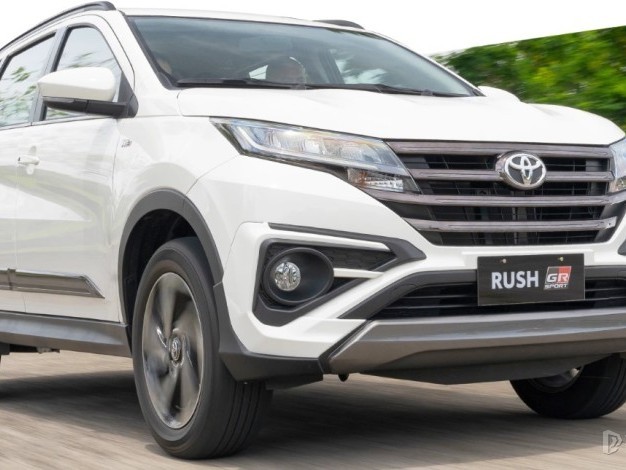Q
Is the Toyota Rush a CVT or automatic?
The Toyota Rush is equipped with an automatic transmission (AT), rather than a continuously variable transmission (CVT). The AT, which utilizes a hydraulic torque converter, connects to the engine and employs internal planetary gears to facilitate gear shifting and torque conversion. Both the 2019 Toyota Rush 1.5G AT and 1.5S AT feature this automatic transmission.
On the other hand, a CVT uses two variable-diameter pulleys and a steel belt to continuously and seamlessly adjust the gear ratio. The AT in the Toyota Rush offers automatic characteristics, allowing drivers to enjoy convenience without the need for manual shifting. This enhances the driving experience by making it more relaxed. Furthermore, the Rush's AT helps deliver the engine's power smoothly to the wheels, ensuring a comfortable ride. With its smooth shifting and reliable operation, the automatic transmission in the Toyota Rush meets the daily driving needs of many consumers.
Special Disclaimer: This content is published by users and does not represent the views or position of PCauto.
Related Q&A
Q
Is Toyota Rush a Jeep?
The Toyota Rush is not a Jeep in the traditional sense, but rather a compact SUV built on the Toyota IMV platform, which leans more towards urban travel in the Malaysian market. This model features a higher ground clearance of approximately 220mm along with a robust and boxy exterior design, offering some light off-road capability. However, its primary focus remains on daily commuting and family use as a city-oriented SUV.
The Rush is equipped with front-wheel drive (with an optional four-wheel drive available in certain markets) and is powered by a 1.5L naturally aspirated engine (2NR-VE model) that delivers a maximum output of 104 PS. The vehicle's tuning prioritizes fuel efficiency over hard-core off-road performance. Compared to professional off-road vehicles like the Jeep Wrangler or Toyota's Land Cruiser series, the Rush lacks features such as part-time four-wheel drive and differential locks, but its compact size and nimble handling make it practical for various road conditions in Malaysia.
For users who occasionally need to tackle muddy or rocky terrain, opting for the four-wheel drive version and adding a skid plate is advisable. However, for serious off-roading, more specialized models are recommended.
Q
How many people can sit in a Toyota Rush?
The Toyota Rush can accommodate up to seven passengers. It features a 3+2+2 seating layout, which is a common configuration for seven-seater vehicles. This arrangement offers flexibility in passenger seating options. The middle row seats come with a 60:40 split-folding design, allowing for one-touch folding and manual adjustment of the incline angle, while the rear row utilizes a 50:50 split-folding design.
This versatility enables various seating configurations to cater to different needs, such as providing extra space for passengers or increasing cargo capacity. Whether you're traveling with family or friends, the seven-seat layout of the Toyota Rush offers a convenient option for group outings.
Q
Is a Toyota Rush AWD?
No, the Toyota Rush available in Malaysia is not an all-wheel drive (AWD) vehicle; it is equipped with a rear-wheel drive (RWD) system. This rear-wheel drive setup provides good balance and handling across various driving conditions. With its seven-seat layout, practical interior space, and decent off-road capability despite being RWD, the Toyota Rush has become a popular choice in the local SUV segment.
It comes with a range of safety features, including multiple airbags and electronic stability control, while the comfortable cabin layout enhances the overall driving experience. Its fuel-efficient gasoline engine and other convenient amenities cater to the needs of many local consumers.
Q
Is Toyota Rush expensive?
The price of the Toyota Rush ranges from RM 93,000 to RM 97,000, and whether this is considered expensive largely depends on individual perspectives and needs. For consumers on a tight budget who require a seven-seater vehicle, this price range may be quite reasonable, especially given the array of standard safety and practical features it offers, including six airbags, electronic stability control, and a 360-degree parking camera system.
From a segment perspective, this pricing is in line with the market positioning for a B-segment compact SUV. However, consumers seeking higher performance or luxury features may find it pricey, especially considering the engine produces a maximum output of 105 PS and that the majority of the seat adjustments are manual.
Q
What type of car is the Toyota Rush?
The Toyota Rush is classified as a B-segment vehicle. With a length of 4,435 mm, width of 1,695 mm, height of 1,705 mm and wheelbase of 2685mm, it features a five-door, seven-seat layout that is suitable for family use. The vehicle weighs between 1,300 and 1,305 kg, and has a fuel tank capacity of 45 liters.
Powering the Rush is a 1.5-liter gasoline engine that delivers a maximum output of 105 horsepower, paired with a rear-wheel-drive system and an automatic transmission (AT). The front suspension consists of MacPherson struts, and the braking system is equipped with ventilated disc brakes.
Safety features are extensive and include an anti-lock braking system (ABS), electronic stability control, and six airbags. Comfort features are well-appointed, with standard automatic climate control, a touchscreen infotainment system, and electric accessories. The seating configuration provides flexibility for both passengers and cargo.
Q
How fast can a Toyota Rush drive?
The Toyota Rush is powered by a naturally aspirated 1.5-liter four-cylinder gasoline engine, which produces 105 horsepower at 6,000 RPM and generates 140 Nm of torque at 4,200 RPM. It is paired with an automatic transmission and features a rear-wheel-drive layout.
While there is currently no official information regarding the Toyota Rush's top speed, considering its engine power, torque, and vehicle characteristics, it may achieve a maximum speed of approximately 160 to 180 km/h under ideal conditions. However, this is merely an estimate.
It is important to note that speeding is not only dangerous but also violates traffic regulations. The focus should be on maintaining a safe driving speed. Additionally, factors such as road conditions, vehicle load, and engine status can impact the actual attainable speed.
Q
What is the safety rating of Toyota Rush?
The Toyota Rush excels in safety features, offering a range of equipment designed to protect both drivers and passengers. Standard active safety systems include ABS (Anti-lock Braking System), Electronic Stability Control, Lane Departure Alert, Automatic Emergency Braking, and Forward Collision Warning, all of which work together to effectively prevent accidents.
In terms of passive safety, the vehicle is equipped with six airbags, including those for the driver, front passenger, front side airbags, and curtain airbags for both front and rear passengers, providing comprehensive protection for occupants. Additionally, the ISOFIX child seat anchors offer safety and convenience for families traveling with children.
While there is no specific safety rating data available, the rich and practical safety features of the Toyota Rush suggest a high level of protection for those inside the vehicle, offering driving safety on every journey.
Q
Can a Toyota Rush go uphill?
The Toyota Rush is capable of tackling inclines with ease. It is equipped with a 1.5-liter gasoline engine that delivers a maximum power output of 105 horsepower. Under normal conditions, this level of power is sufficient to propel the vehicle uphill. Additionally, features like rear-wheel drive provide enhanced traction and stability when ascending.
The vehicle also comes standard with a Hill Start Assist feature, which prevents rollback when starting on a slope, giving drivers added confidence during incline driving. With a ground clearance of 220 millimeters, the Rush is well-equipped to handle rugged terrain without the risk of wearing the bottom. With these capabilities, the Toyota Rush is well-prepared to navigate climbing scenarios effortlessly.
Q
Is a Toyota Rush a 7-seater layout?
Yes, the Toyota Rush is a 7-seater vehicle. It features a 3+2+2 seating configuration, comfortably accommodating seven passengers. This makes it a practical choice for families or groups in need of extra seating. Compared to smaller vehicles, its seven seats provide the flexibility to transport more people.
Whether for daily commutes, road trips, or carrying larger groups, the 7-seat configuration of the Toyota Rush offers convenience and practical functionalities. Additionally, the interior design and seating arrangement are crafted to ensure sound comfort for all passengers.
Q
Which car category does Toyota Rush belong to?
The Toyota Rush falls into the B-segment compact SUV category. With a body length of 4,435 mm, a width of 1,695 mm, a height of 1,705 mm, and a wheelbase of 2685mm, it boasts a compact overall size. This model features characteristics suitable for both urban driving and light off-roading, with a minimum ground clearance of 220 mm that contributes to its good passability.
The interior is designed with a 7-seat layout, providing flexible seating options. The second row features a 60:40 split-folding design that allows for one-touch folding and manual reclining, while the third row has a 50:50 split-folding capability, catering to various passenger and cargo needs. In terms of powertrain, the Rush is equipped with a 1.5L naturally aspirated engine paired with an automatic transmission and rear-wheel drive, offering stable power support for daily commutes and occasional outdoor adventures.
Popular Cars
Model Year
Car Compare
Car Photo
Latest Q&A
Q
How much is the 2024 Vanquish?
The specific selling price of the 2024 Aston Martin Vanquish has not been officially announced yet, but based on the market positioning of the previous generation model and supercars in the same class, the starting price is expected to be between RM1.5 million and RM2 million, and the specific price will fluctuate depending on optional configurations and tax rates. As Aston Martin's flagship GT sports car, Vanquish is typically equipped with a V12 engine with a power output of over 600 horsepower, and features a carbon fiber structure and luxurious handmade interior that balances performance and comfort. It should be noted that these high-end sports cars often require advance booking and long delivery cycles. It is recommended to directly contact authorized dealers for the latest information, including customization options and financial solutions. In the same price range, models such as Ferrari Roma or Bentley Continental GT can also be considered, each with its own characteristics. For example, Roma leans more towards sporty handling, while Continental GT emphasizes luxury travel experience, and consumers can choose according to their own needs.
Q
What engine is in the Vanquish 2024?
The 2024 Vanquish is expected to pack a fortified 5.2-liter V12 twin-turbocharged engine, sourced from Aston Martin’s flagship powertrain lineup. With power likely bumped to around 700 horsepower and torque peaking at 800 Nm, it’s paired with an 8-speed automatic transmission—balancing blistering performance with seamless shifts.
The aluminum block and twin-scroll turbos keep weight in check while sharpening throttle response, and cylinder deactivation helps with fuel efficiency when you’re not chasing the horizon. As Aston’s GT flagship, the Vanquish’s tuning prioritizes low-end grunt, making it equally at home on cross-country hauls or twisty mountain passes.
Worth noting: these big-displacement turbo engines handle tropical climates with ease, thanks to cooling systems specifically tweaked for high-temperature resilience—critical when pushing hard. For those craving extra edge, optional carbon-ceramic brakes and rear-wheel steering dial up the agility, ensuring composure even when the roads get unpredictable.
Q
What does a 2024 Aston Martin cost?
The 2024 Aston Martin lineup sees significant price variations depending on model and specifications. The entry-level Vantage starts at approximately RM1 to 1.2 million, while the DB12 ranges between RM1.5 to 1.8 million. Flagship performers like the DBS 770 Ultimate or limited-run Valhalla can easily surpass RM3 million. These figures typically cover base configurations, though costs rise with optional performance packs, bespoke interiors, or specialty paintwork.
As a handcrafted British luxury marque, Aston Martins feature either uprated 4.0L V8 twin-turbo or 5.2L V12 powertrains, paired with cutting-edge tech like intelligent suspension and digital cockpits. Buyers should consult authorized dealers for exact configurations—the brand’s personalization program allows extensive customization of materials and finishes.
Pro tip: Factor in elevated insurance and maintenance costs. These high-performance machines follow specialized service schedules, so review aftersales policies beforehand. Always confirm final pricing with your dealer, as options dramatically impact the bottom line.
Q
How much is the 2024 Aston Martin Vanquish?
The specific selling price of the 2024 Aston Martin Vanquish has not yet been officially announced by the official, but based on the pricing strategy of the previous generation model and brand, it is expected that the starting price will remain in the range of 300000 to 400000 US dollars, and the specific price will be adjusted according to optional configurations and exchange rate fluctuations. As the flagship GT sports car of the brand, Vanquish continues the classic British design language, equipped with an enhanced V12 engine with a maximum power of over 600 horsepower, and equipped with a new generation of adaptive suspension and carbon fiber body technology, achieving a balance between luxury and performance. It is worth noting that these ultra luxury models are usually produced on an order basis with a long delivery cycle. It is recommended to obtain customized quotes through authorized dealers. Competitors in the same class include Ferrari Roma and Bentley Continental GT, but Vanquish emphasizes the combination of long-distance comfort and driving pleasure. Its iconic grille design and hand sewn interior craftsmanship also continue the brand's unique recognition.
Q
Does the 2019 Kia Cerato have Apple CarPlay?
The 2019 Kia Cerato did come equipped with Apple CarPlay, which was a pretty standard tech feature for its class at the time. It lets you mirror your iPhone’s navigation, music, and calls onto the car’s display via USB—handy for keeping things safe and convenient on the road. Android Auto was also onboard, so it covered both major phone ecosystems. The 8-inch touchscreen was responsive, with a clean interface that made it easy to use.
Just a heads-up: for the best CarPlay experience, make sure your iPhone’s OS is compatible and use an original cable. Back in 2019, rivals like the Toyota Corolla and Honda Civic offered similar tech, but the Cerato stood out for its value, especially if you wanted solid features without overspending. If you run into any hiccups with CarPlay, the owner’s manual or a dealership visit should sort you out.
View MoreRelated News

The compact SUV Toyota Rush, which has already been discontinued in Malaysia, does anyone around you drive it?
AshleyJul 25, 2024

Toyota Leads Global Sales in 2023, Despite 8% Decline but Tops Thailand
Kevin WongFeb 23, 2024

Toyota Raize: When will this smart and compact SUV be available in Malaysia?
AshleyDec 2, 2025

Why is the Toyota Sienna so popular with so many people?
RobertDec 1, 2025

Toyota unveils the new Corolla at the Auto Guangzhou in China. What changes will the future Corolla have?
AshleyNov 25, 2025
View More

















Pros
Cons